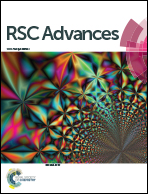Polystyrene core–silica shell composite particles: effect of mesoporous shell structures on oxide CMP and mechanical stability
Abstract
Organic/inorganic composite particles with a core–shell structure exhibit potential applications in chemical mechanical polishing/planarization (CMP) for mechanically challenging materials (copper and low-k dielectrics etc.). In this work, the spherical composites comprised of polystyrene (PS) cores and mesoporous silica (mSiO2) shells were synthesized through a self-assembly of cetyltrimethylammonium bromide and silicate oligomers combined with a selective etching strategy. The composites with sponge-like (composites-A) or worm-like shells (composites-B) were obtained by adjusting the stirring rate in the synthesis processes. The oxide CMP performances of the composites with different shell structures were compared in terms of surface finishing and material removal rate (MRR). Polishing results showed that the particles consisted of mesoporous shells (composites-A and -B) and presented a lower surface roughness and higher MRR than those of the composites with CTAB/SiO2 nonoporous shells (composites-C), indicating that the mSiO2 shells contributed to the reduction of indentation depth (surface roughness) and improvement of MRR. The average root-mean-square (RMS) roughness and MRR for composites-A were 2.65 Å and 65 nm min−1, respectively, which were comparable to the measured values for composites-B (2.07 Å and 75 nm min−1). As confirmed by FESEM, the sponge-like shells in some of composites-A peeled off, whereas the radial mSiO2 shells for most of composites-B were not disrupted. An improved organization of mesochannels in the silica shells is beneficial to the enhanced mechanical and structural stability of PS/mSiO2 composite particles during CMP applications.



 Please wait while we load your content...
Please wait while we load your content...